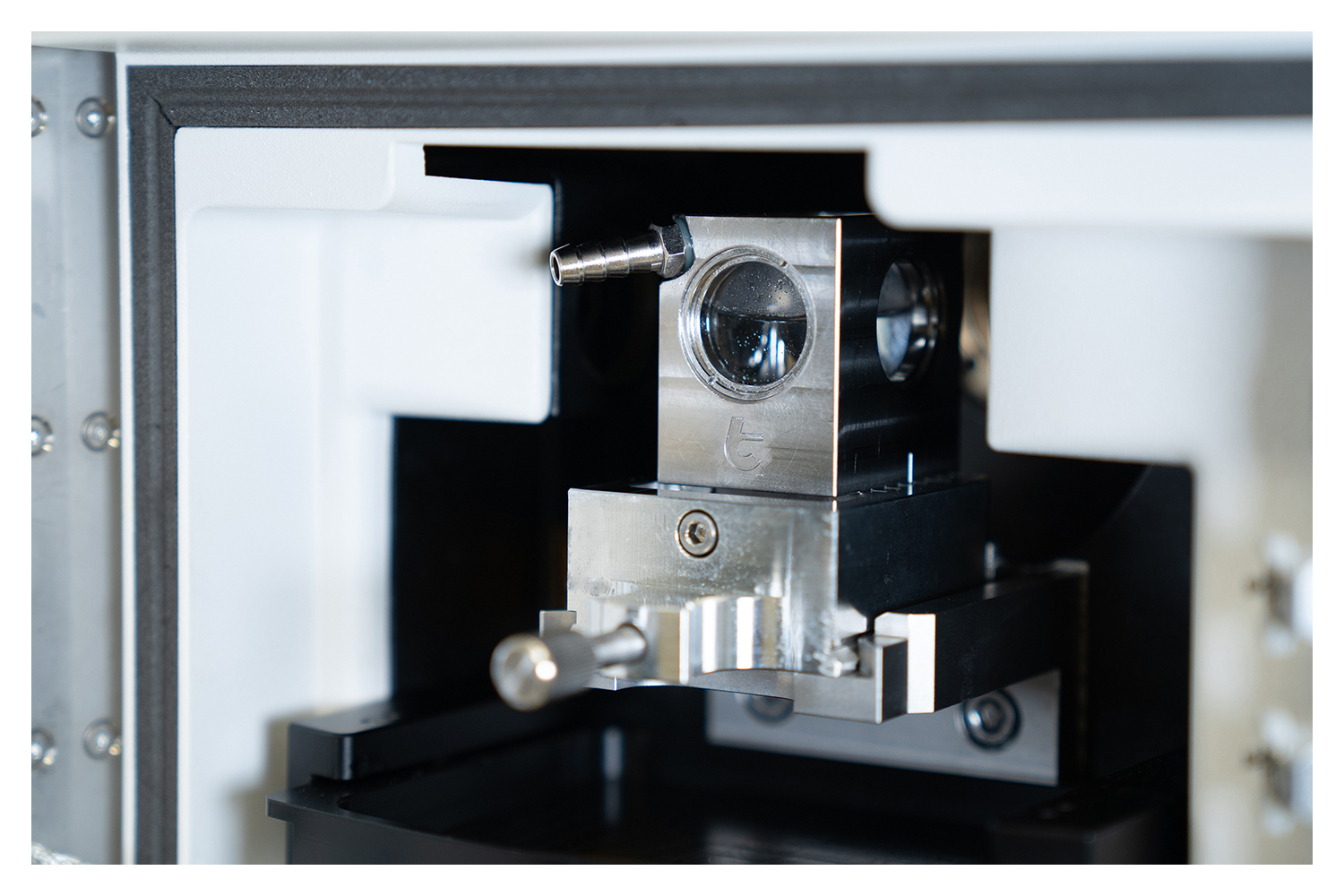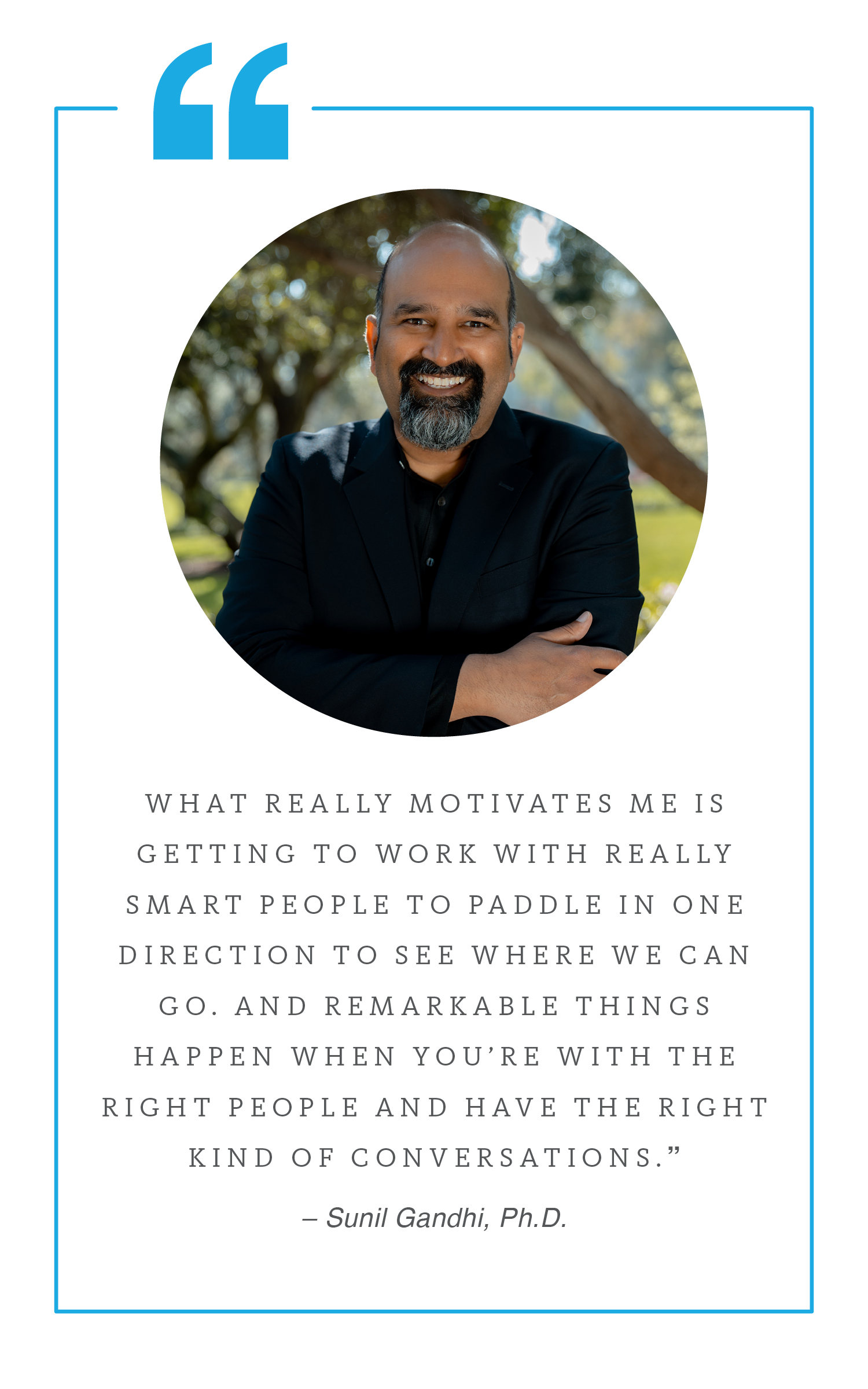The associate professor of Neurobiology and Behavior explores new ways to image the brain and improve its function.
New York City is the home of the New York Yankees, the site of the first pizzeria in the United States and the birthplace of singer-songwriter Alicia Keys. The Big Apple can also lay claim to the place in which a young boy picked up a book filled with colorful and intricate renderings of what goes on inside the brain that inspired a lifelong quest to learn more about the center of the human nervous system.
That child would become Sunil Gandhi, Ph.D., associate professor of Neurobiology and Behavior in the School of Biological Sciences at UC Irvine (UCI) and associate director of the Center for the Neurobiology of Learning and Memory (CNLM), whose interest in the brain’s inner workings has only intensified.
FORMING CONNECTIONS
Picking up that book in New York City would drive Gandhi to see the brain for himself. He even recalls a self-guided project he undertook in elementary school that focused entirely on the brain.

“That set up all of these dreams and imaginings for what could be possible in the future,” said Gandhi. “My scientific career has just been motivated by that desire to see what those artists had drawn in that book from my childhood.”
In his undergraduate studies, however, Gandhi was more interested in computer science and symbolic systems than neuroscience. That was until he took a course from a computer scientist-turned-neuroscientist that got him thinking about the brain as a computer, which brought his thoughts back to the brain.
“Biology is way more interesting and enigmatic than a computer and so I came at it from that perspective,” said Gandhi. “And he strongly influenced me in terms of the kinds of scientific questions I was interested in.”
As part of his capstone project as an undergraduate, Gandhi gained access to an MRI machine to study his own brain to understand how attention works in the visual system. That experience reinvigorated his love for neuroscience, which he pursued in graduate school, eventually working on a technology that enabled a basic view of signaling between neurons across a synapse, which was published in Nature.
Gandhi then took what he had learned and further explored this in his postdoctoral work. Using advanced microscopy tools, Gandhi would continue to investigate how the visual system in the brain develops.
THOUGHT EXPERIMENT
As with many great ideas, Gandhi recalls one that came about during a late-night conversation with a friend on a beach in Northern California. The two discussed the seemingly farfetched idea of transplanting inhibitory neurons from an embryo into an adult brain with the hope of activating a critical period — or time of pronounced brain plasticity. A discovery like this could enable the growth and reorganization of synaptic connections in an adult brain, and the potential for repairing the brain could prove revolutionary for the scientific and medical communities. But after getting the opinion from colleagues, the idea was dismissed.
 “I was told these experiments would lead nowhere … and so we did the experiment anyway,” said Gandhi. “What we found was that we could create a new critical period. But that’s the way it is with ideas; sometimes you can’t accept them until you see the evidence, and when the evidence is there, you can’t imagine not having accepted them before.”
“I was told these experiments would lead nowhere … and so we did the experiment anyway,” said Gandhi. “What we found was that we could create a new critical period. But that’s the way it is with ideas; sometimes you can’t accept them until you see the evidence, and when the evidence is there, you can’t imagine not having accepted them before.”
His postdoctoral study on renewing the critical period using neural transplantation would go on to be published in Science. This experience would both give Gandhi the fortitude to explore more innovative ideas down the road as well as launch his independent scientific career. It also became the basis for his work as a professor at UCI, where he continues to investigate the mechanisms of critical period activation along with using advanced imaging tools to understand the organization and reorganization of brain circuits, primarily by looking at the visual cortex — the part of the brain that processes visual information.
ENTREPRENEURIAL MINDSET
According to Gandhi, the field of neuroscience has experienced a sea change when thinking about the commercialization of research tools and ideas. With guidance from the National Institutes of Health (NIH) and its Brain Research through Advancing Innovative Neurotechnologies (BRAIN) Initiative, there has been an increased focus on progressing the science of the brain with the dissemination of advanced research tools and concepts through commercial and academic pathways.

With the neuroscience field’s new focus on commercialization in mind, Gandhi was primed to advance neuroscience through his own commercial endeavor when the opportunity arose. Then, at the 2018 International CNLM spring meeting, which drew nearly 1,000 attendees from 30 countries, he reconnected with friend Damian Wheeler, Ph.D., who was interested in the same technology that Gandhi’s lab was developing. The two decided to work on commercializing that technology together.
To get this technology into the hands of others who could use it to advance their own research, the two co-founded Translucence Biosystems, which aimed to offer comprehensive 3D tissue analysis, rather than traditional 2D analysis. The startup chemically treats biological samples so that they appear transparent, then image the tissue in 3D with special optics and analyze the data.

With their advanced processes, the Translucence Biosystems team can map an entire mouse brain at the cellular level in three dimensions, a groundbreaking feat for the field of neuroscience. One of the company’s key differentiators was the Mesoscale Imaging System — a novel imaging chamber, specimen holder and safety collar — that attaches to a special microscope created by Zeiss, an internationally recognized optics and optoelectronics company. The
Mesoscale Imaging System allows larger samples to be studied, capitalizing on the microscope’s superior optics and resolution.

To kick off their endeavor, Gandhi and CEO Wheeler spent an entire weekend writing two successful NIH Small Business Innovation Research grant proposals that went toward further developing their technology. Zeiss also encouraged Translucence Biosystems to commercialize the novel Mesoscale Imaging System and partnered with the team to co-market the microscope attachment system.
“We managed to get lucky and meet just the right people at the right time,” said Gandhi. “There are a lot of people at Zeiss that helped make this happen. Zeiss encouraged us to commercialize that hardware and software toolkit, which became an early revenue stream and, along with the SBIR awards, were very important in supporting the company.”
The startup currently occupies space at TechPortal, a business technology incubator at the California Institute for Telecommunications and Information Technology, and at University Lab Partners, a wet lab and incubator located inside the Cove @ UCI.
THINKING AHEAD
 Gandhi, who is part of UCI Beall Applied Innovation’s Faculty Innovation Fellows program, recently received Applied Innovation’s Entrepreneurial Leader of the Year Award for his achievements in commercializing university intellectual property. He aims to advance the field of neuroscience through academia and his entrepreneurial endeavors, which includes Translucence Biosystems and a new company formed with two fellow UCI professors that intends to use cell therapy to treat neurodegenerative diseases.
Gandhi, who is part of UCI Beall Applied Innovation’s Faculty Innovation Fellows program, recently received Applied Innovation’s Entrepreneurial Leader of the Year Award for his achievements in commercializing university intellectual property. He aims to advance the field of neuroscience through academia and his entrepreneurial endeavors, which includes Translucence Biosystems and a new company formed with two fellow UCI professors that intends to use cell therapy to treat neurodegenerative diseases.
“What really motivates me is getting to work with really smart people to paddle in one direction to see where we can go,” said Gandhi. “And remarkable things happen when you’re with the right people and have the right kind of conversations.”
What started out as a simple desire to see what goes on inside the brain has become meaningful contributions to the field of neuroscience and technologies that may end up having real clinical implications.
Learn more about the Gandhi Lab.
All Photos and Graphics: Julie Kennedy, UCI Beall Applied Innovation
Main Graphic Illustration: Rachel Noble
Produced by UCI Beall Applied Innovation
Directed & filmed by Julie Kennedy
Edited by Elisa Le
Mouse brain rendering provided by Translucence Biosystems